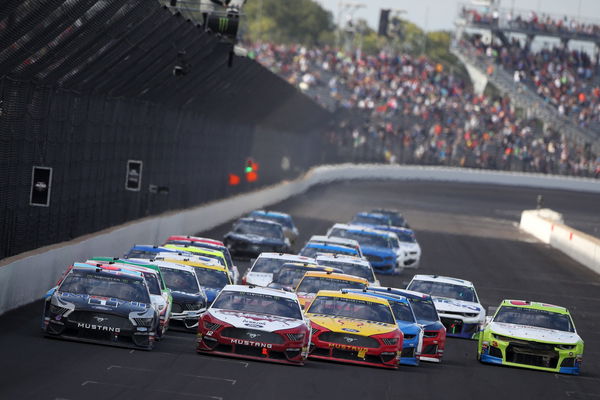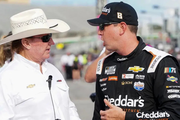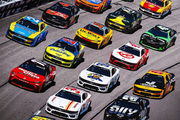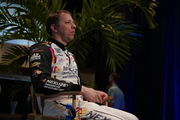
via Getty
INDIANAPOLIS, INDIANA – SEPTEMBER 08: Kevin Harvick, driver of the #4 Mobil 1 Ford, leads during the Monster Energy NASCAR Cup Series Big Machine Vodka 400 at the Brickyard at Indianapolis Motor Speedway on September 08, 2019 in Indianapolis, Indiana. (Photo by Chris Graythen/Getty Images)

via Getty
INDIANAPOLIS, INDIANA – SEPTEMBER 08: Kevin Harvick, driver of the #4 Mobil 1 Ford, leads during the Monster Energy NASCAR Cup Series Big Machine Vodka 400 at the Brickyard at Indianapolis Motor Speedway on September 08, 2019 in Indianapolis, Indiana. (Photo by Chris Graythen/Getty Images)
“A badly missed call,” commented Kevin Harvick, after the Brickyard 400 race. NASCAR drivers may be enjoying their vacation time, but the Cup garage is still not over how those final laps unfolded. It looked like a story between Brad Keselowski and Ryan Blaney – but Kyle Larson butted between them. Then, everything fell in place for Larson’s glory – from Keselowski’s fuel run-out to NASCAR’s delayed caution call.
So the higher-ups have been under fire for the past few days for their questionable call. The driver who voiced his protests the most was Ryan Blaney, as he saw his sure-shot victory slip through his fingers. Others also joined in his rant against NASCAR. However, a top executive recently attempted to explain the controversial decision.
ADVERTISEMENT
Article continues below this ad
NASCAR senior VP tries to justify the Indy call
NASCAR’s return to the Indianapolis Motor Speedway after a three-year gap was supposed to be dotted with pomp and circumstance. Instead, it was riddled with wrecks and controversy. With two laps to go in the second overtime attempt, Stewart-Haas Racing’s Ryan Preece encountered trouble. He spun off Turn 2 on contact from Chase Elliott and hit the inside wall. He tried to keep the No. 41 Ford rolling but bizarrely froze mid-track. But NASCAR did not call a caution; Kyle Larson took the lead – until the race leaders were at Turn 1.
This drew flak from a large portion of the NASCAR community, especially, Ryan Blaney. He argued that the higher-ups blatantly allowed Larson to grab the upper hand. However, as NASCAR’s Senior VP of Competition, Elton Sawyer tried to justify Larson’s lead, he also argued in favor of the much-criticized decision to call a late caution. Sawyer started with a general philosophy the sport follows on SiriusXM NASCAR: “For our fans, our goal at every event is to finish under green. That is what our goal is going into the weekend.”
Elton Sawyer further tried to reason that they wanted to see if Preece could proceed further. “Both, we’re trying to give that car every opportunity to get started, get rolling, and let the race end naturally. As we came off Turn 4 and came to the start/finish line for the white flag (at Indy), it’s a two-and-a-half mile racetrack, so you still have a lot of racing that can happen. As the cars started to get off in Turn 1, you’re starting to get closer to having to make a decision. That’s our process. That’s our mindset.”
View this post on Instagram
What’s your perspective on:
Did NASCAR's caution call at Indianapolis ruin the race, or was it a necessary move?
Have an interesting take?
NASCAR’s officials could not give much thought to the decision as Ryan Preece’s incident happened in a flash. So, Elton Sawyer tipped his hat to the official who took that crucial, yet debated call. “As they are racing, you can’t let them race through a situation where you’ve got a car stopped on the racetrack. So that was our decision process and how we kind of digest that very quickly. I might add we have now had the opportunity for 24 hours, 48 hours to kind of digest it and I still go back and think our race director did a really good job in the way he managed that.”
ADVERTISEMENT
Article continues below this ad
Even as NASCAR attempts to cover up its alleged mistake, this is not the only one it needs to tend to. Although Kyle Larson has no qualms about the caution call, his Hendrick Motorsports teammate called out the higher-ups.
Trending
An apparent miscommunication riled up a Hendrick driver
Long before the final-lap controversy erupted, NASCAR got caught in criticism during the wee laps of the Brickyard 400. On lap 25 of the race, some leaders took pit stops, including Chase Elliott. Yet he managed to score a pit road penalty. On the previous day, NASCAR had clarified the pit road acceleration rule, a part of which asked the drivers to “stay off the racing surface,” while returning to the track. In the middle of Turns 1 and 2, Elliott’s car drifted out of the acceleration lane and over two painted white lines. And he had all four tires on the racing surface.
ADVERTISEMENT
Article continues below this ad
After getting slapped with the penalty, Elliott was dumbfounded. He fumed over the radio: “I did what the f***ing sheet said to do.” Following this pit rule confusion, Elton Sawyer swooped in for the rescue yet again. He clarified the rule once again: “As you look at the video, that basically says that you have to stay in the acceleration lane there … until you exit Turn 2, then you blend up on the racetrack.” Sawyer noted that NASCAR sent additional information to clear up any kind of miscommunication. They also tried “to help clarify any confusion that may have come out of the videos that at no point could you go up on the racing surface.”
Yet, evidently, Chase Elliott and the No. 9 team were left scratching their heads at the sudden penalty. So, even as Sawyer tried to clear up the messy situation that NASCAR faced in Indianapolis, the higher-ups would continue to receive flak for their Brickyard 400 slip-ups.
ADVERTISEMENT
ADVERTISEMENT
ADVERTISEMENT
ADVERTISEMENT







Did NASCAR's caution call at Indianapolis ruin the race, or was it a necessary move?